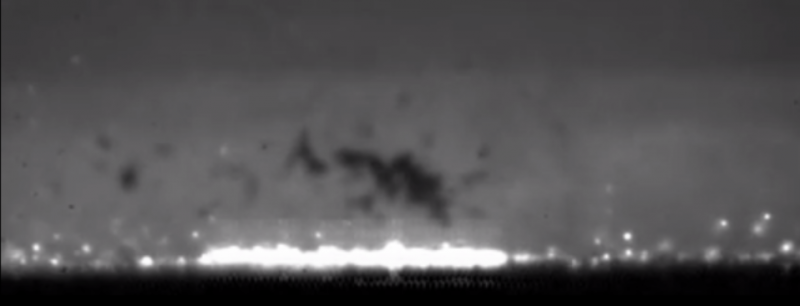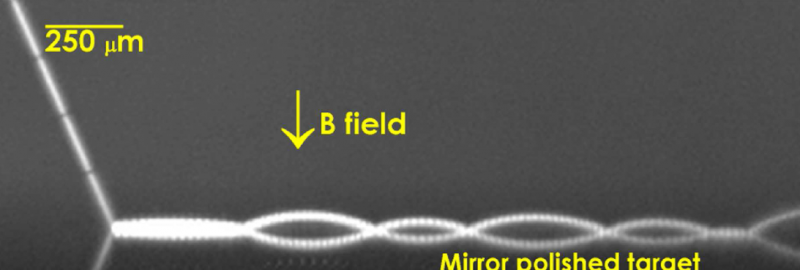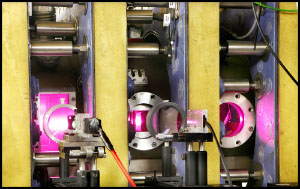When the hot, dense plasma in a fusion reactor hits the reactor's exhaust wall, dust particles will inevitably erode from the wall and be swept away by the plasma, or ionised gas. But how do these dust particles travel and where do they end up? An international team has used sensitive cameras to produce the first ever fully resolved movies of dust motion in experiments with DIFFER's linear plasma generator Pilot-PSI. The new data will feed into improved models for dust motion in the fusion reactor ITER.
Article
Highly resolved measurements of dust motion in the sheath boundary of magnetized plasmasA. Shalpegin et.al.*, Nuclear Fusion
* This work was carried out under Eurofusion Enabling Research Project WP14-ER-01/VR-01
As a first test of the new camera system, the team filmed how a dust patch (not representative of the dust particles in a fusion reactor) remobilizes from a surface. Click to see the youtube movie - credit: Andrey Shalpegin et.al.*, Nuclear Fusion
"Dust particles are a few millionth of a meter (micrometer) in size. A challenge with detecting their minute motions is that you want to have the camera really close to the plasma", says Pilot-PSI operator Kirill Bystrov. In a complete fusion reactor, designed to produce energy from the same process powering the sun, there is seldom the space to do that - instrumentation ports are too far away from this plasma-surface interaction region. "In Pilot-PSI, we can get the camera within half a meter of where the plasma hits the target."
Record resolution
The experiments reached a record spatial sensitivity of 9 micrometers per pixel. Previous experiments reached 200 micrometers to a few millimeters per pixel - ten to fifty times less sensitive than the record set in Pilot-PSI. This gives unparallelled information about how the dust particles roll, skip and bounce, and how they are influenced by the constant wind of plasma particles. This information will feed into predictive models for the dust motion, to clear up where it will collect and which reactor areas need special focus when cleaning.
Tracks of different types of dust particle in the plasma beam of Pilot-PSI: small velocity (a) loss to large velocity loss (b) and even sticking. Once a dust particle sticks to the surface, it cools down and is no longer visible. Click to see movie of sticking and bouncing dust - credit: Andrey Shalpegin et.al.*, Nuclear Fusion
Mysterious sliders
The new measurements managed to clear up a mysterious form of motion where a dust speck kept its high temperature while sliding across a cooled surface. Intuitively, that just cannot happen: the particle should cool down to the surface temperature if it is in constant contact. It turns out the 200 micrometer per pixel resolution of the original measurements was to blame - where they saw a particle rolling or sliding in constant contact with the cooled surface, the more accurate 9 micrometer video clearly shows the dust speck bouncing across the surface and only cooling down a fraction when it strikes the surface between bounces.
The new camera system pioneered in this research can resolve this particle as bouncing over the surface; previously, this would have been identified as a particle sliding over the surface but somehow not cooling down to the surface temperature. See the movie - credit: Andrey Shalpegin et.al.*, Nuclear Fusion
International attention
"These dust experiments were probably our most international ones yet", thinks Bystrov. To track the motion of minute dust specks in the blindingly hot plasma beam, a team assembled from Université de Lorraine, Universität Stuttgart, the Swedish Royal Institute of Techology, Institute di Fisica del Plasma CNR and the ITER organisation. Russian plasma physicist Bystrov performed his PhD research at DIFFER and stayed on to manage Pilot-PSI, one of the institutes devices for studies of plasma-surface interaction and one of few in the world which can mimic plasma conditions near a fusion reactor wall in a laboratory setting. Pilot-PSI is the last DIFFER experiment still running at the institute's old location in Nieuwegein; at the start of 2015, all other experiments have been dismantled and moved to the new building in Eindhoven. "We kept Pilot running to answer the demand for experimental time from experimental partners", says Bystrov. The facility has run for full working weeks of two shifts per day since Spring of 2015.
Pilot-PSI is the last DIFFER experiment still running at the institute's old location in Nieuwegein; at the start of 2015, all other experiments have been dismantled and moved to the new building in Eindhoven. "We kept Pilot running to answer the demand for experimental time from experimental partners", says Bystrov. The facility has run for full working weeks of two shifts per day since Spring of 2015.
Go to the News page.